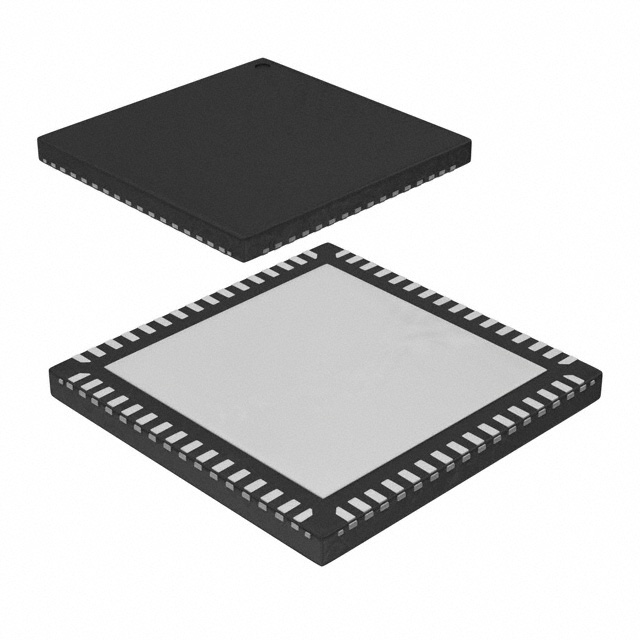Lihat spesifikasi untuk detail produk.

ATXMEGA192C3-MNR
Product Overview
Category
ATXMEGA192C3-MNR belongs to the category of microcontrollers.
Use
It is primarily used for embedded systems and applications that require a high level of control and processing power.
Characteristics
- High-performance microcontroller with advanced features
- Low power consumption
- Extensive peripheral set
- Large memory capacity
- Real-time performance
Package
ATXMEGA192C3-MNR is available in a compact and durable package, suitable for various environments.
Essence
The essence of ATXMEGA192C3-MNR lies in its ability to provide efficient and reliable control for complex electronic systems.
Packaging/Quantity
ATXMEGA192C3-MNR is typically packaged individually and is available in varying quantities depending on the manufacturer's specifications.
Specifications
- Microcontroller architecture: AVR
- CPU speed: 32 MHz
- Flash memory: 192 KB
- RAM: 8 KB
- Operating voltage: 1.6V - 3.6V
- Number of I/O pins: 32
- Communication interfaces: UART, SPI, I2C
- Analog-to-Digital Converter (ADC) channels: 12-bit, 16 channels
- Timers/Counters: 4 x 16-bit, 1 x 12-bit
- PWM channels: 8
- Operating temperature range: -40°C to +85°C
Detailed Pin Configuration
The ATXMEGA192C3-MNR microcontroller has a total of 44 pins, each serving a specific purpose. The pin configuration is as follows:
- Port A: PA0 to PA7
- Port B: PB0 to PB7
- Port C: PC0 to PC7
- Port D: PD0 to PD7
- Port E: PE0 to PE7
- Port F: PF0 to PF7
Each pin can be configured as an input or output, and some pins have additional functionalities such as interrupt capability or analog input.
Functional Features
1. High-performance CPU
The ATXMEGA192C3-MNR is equipped with a powerful CPU that operates at a speed of 32 MHz, allowing for fast and efficient execution of instructions.
2. Extensive Peripheral Set
This microcontroller offers a wide range of peripherals, including UART, SPI, and I2C interfaces, which enable seamless communication with other devices.
3. Advanced Analog-to-Digital Conversion
With its 12-bit ADC channels, the ATXMEGA192C3-MNR provides accurate and precise analog-to-digital conversion, making it suitable for applications that require high-resolution measurements.
4. Timers/Counters and PWM Channels
The microcontroller features multiple timers/counters and PWM channels, allowing for precise timing control and generation of analog-like signals.
5. Low Power Consumption
ATXMEGA192C3-MNR is designed to operate efficiently with low power consumption, making it ideal for battery-powered applications.
Advantages and Disadvantages
Advantages
- High-performance CPU for fast processing
- Extensive peripheral set for versatile applications
- Advanced analog-to-digital conversion for accurate measurements
- Multiple timers/counters and PWM channels for precise timing control
- Low power consumption for energy-efficient operation
Disadvantages
- Limited availability of alternative models
- Steep learning curve for beginners due to advanced features
Working Principles
The ATXMEGA192C3-MNR microcontroller follows the AVR architecture, which utilizes a Harvard architecture with separate program and data memories. It executes instructions fetched from the flash memory and stores data in the RAM. The CPU processes these instructions and interacts with various peripherals to perform desired tasks.
Detailed Application Field Plans
The ATXMEGA192C3-MNR microcontroller finds applications in various fields, including but not limited to:
- Industrial Automation: Control systems for manufacturing processes, robotics, and machinery.
- Internet of Things (IoT): Smart home automation, sensor networks, and remote monitoring systems.
- Automotive: Engine control units, dashboard displays, and vehicle diagnostics.
- Medical Devices: Patient monitoring systems, medical imaging equipment, and laboratory instruments.
- Consumer Electronics: Home appliances, gaming consoles, and audio/video equipment.
Alternative Models
While the ATXMEGA192C3-MNR is a highly capable microcontroller, there are alternative models available that offer similar functionalities. Some notable alternatives include:
- ATmega2560: A popular microcontroller with a larger memory capacity and more I/O pins.
- PIC32MX795F512L: A microcontroller from Microchip with similar features and performance.
- STM32F407VG: An ARM-based microcontroller with advanced peripherals
Sebutkan 10 pertanyaan dan jawaban umum terkait penerapan ATXMEGA192C3-MNR dalam solusi teknis
Sure! Here are 10 common questions and answers related to the application of ATXMEGA192C3-MNR in technical solutions:
Q: What is the ATXMEGA192C3-MNR microcontroller used for? A: The ATXMEGA192C3-MNR is a microcontroller designed for various embedded applications, including industrial control systems, automation, and IoT devices.
Q: What is the maximum clock frequency supported by the ATXMEGA192C3-MNR? A: The ATXMEGA192C3-MNR can operate at a maximum clock frequency of 32 MHz.
Q: How much flash memory does the ATXMEGA192C3-MNR have? A: The ATXMEGA192C3-MNR has 192 KB of flash memory for storing program code.
Q: Can I expand the memory of the ATXMEGA192C3-MNR? A: Yes, the ATXMEGA192C3-MNR supports external memory expansion through its External Bus Interface (EBI).
Q: What communication interfaces are available on the ATXMEGA192C3-MNR? A: The ATXMEGA192C3-MNR features USART, SPI, and I2C interfaces for communication with other devices.
Q: Does the ATXMEGA192C3-MNR support analog-to-digital conversion? A: Yes, the ATXMEGA192C3-MNR has a built-in 12-bit Analog-to-Digital Converter (ADC) with multiple channels.
Q: Can I use the ATXMEGA192C3-MNR for low-power applications? A: Absolutely! The ATXMEGA192C3-MNR offers various power-saving features, including sleep modes and event system triggers.
Q: What programming languages can I use to develop applications for the ATXMEGA192C3-MNR? A: You can program the ATXMEGA192C3-MNR using C or assembly language.
Q: Are there any development tools available for the ATXMEGA192C3-MNR? A: Yes, Atmel Studio is a popular Integrated Development Environment (IDE) that supports programming and debugging of the ATXMEGA192C3-MNR.
Q: Where can I find documentation and resources for the ATXMEGA192C3-MNR? A: You can find datasheets, application notes, and other resources on the official Microchip website or through their support channels.
Please note that these questions and answers are general and may vary depending on specific requirements and use cases.

